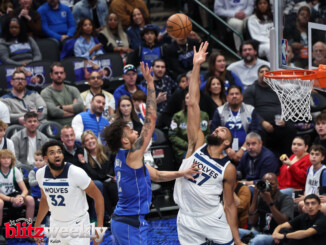
The Dallas Mavericks take on the Phoenix Suns on Dec. 5. Eric Bledsoe fights past J.J. Barea.
By Lance Rinker
The Dallas Mavericks have been a team not to be trifled with on offense, averaging a league best 110.6 points per game and are 16-1 when scoring more than 100 points.
Advanced metrics all point to the Mavericks having one of the most potent offenses in the NBA, thus backing up the videogame point totals routinely put up by the team. However, according to Mavs coach Rick Carlisle, all is not rainbows and sunshine.
“…Transition defense is an area where we have to improve,” Carlisle said, after the team’s Friday morning practice ahead of the matchup with the Phoenix Suns. “We’re not where we need to be there.”
Dallas is the least efficient team in preventing fast break points so far this season, according to data from teamrankings.com. The Mavericks were the third worst team in preventing fast break points last season, so it’s becoming a trend.
Fast break points happen when a team on defense is particularly lazy or slow in transition. That allows the opposing team to cut through a defender with relative ease and take a long or quick pass to the basket for easy points.
That’s one reason why the Mavs have seemingly struggled with teams that immediately rush down the court on offense after a Mavs bucket. Often enough a Mavs player has not gotten into proper position during that transition from offense to defense. The result is easy pickings for the opposing team to lob a pass down court for an easy layup.
Hence the reason why the Suns were able to dispatch the Mavs the way they did Friday night. The Suns managed to score 27 fast break points, and the Mavs have allowed opposing teams to score 20 or more fast break points against them in all but 12 games so far this season.
Maybe you’re thinking, “hey, that’s like half the team’s games this season…” but don’t be fooled.
The bulk of those games the team gave up less than 20 fast break points happened during the first two weeks of the season, when teams are still finding their rhythm offensively, and the rest against teams that shouldn’t come close to scoring double-digit fast break points against a team like the Mavs.
The bright spots are giving up zero fast break points to the Charlotte Hornets, nine to the Philadelphia 76ers and just 11 to the Los Angeles Lakers. The low points are getting crushed for 30 by the Washington Wizards, 27 by the Suns and of course the fact the Mavs being unable to shut down offensively competent teams, or fast paced teams, off the transition.
What is important to remember about how effective transition defense works is the fact that it actually begins on offense. How well a team is set up on defense after an offensive possession largely depends on how quickly players get in position, and not have their backs to opposing players, after wrapping up an offensive possession.
According to Rich Stoner, basketball skills trainer and USAW certified Sports Performance Coach, in addition to owner of Elite Basketball Training, there are several keys to having an effective transition defense.
Transition defense is about defending the basket and not a man. It all begins on offense where at least one, if not two, offensive players should rotate back to the top of their offense. This will enable them to get ahead of the basketball and prevent an easy scoring opportunity. The player closest to the offensive player who grabbed the rebound should pressure that player and prevent an easy outlet pass.
The first two players back on defense need to communicate with each other to ensure that the basket is protected and that the ball is stopped. They should play in a tandem alignment with the top defender covering the ball and the bottom player covering the basket. The third defensive player should form a triangle and the fourth defensive player should form a square.
Both situations will provide support from the weak side and allow someone to match up with the ball on any skip pass. Finally, the last player back should run to the middle of the lane and see who is open and match up accordingly.
Even though the team just wrapped up another week where they went 3-1, and continue to find ways to win close games when Dirk needs a rest, if they don’t improve on transition defense soon then things could go downhill.
Those 3-1 weeks could soon become 2-2 weeks and all of a sudden they lose ground in their division and in the Western Conference. The Mavs, at 16-6, would lead every division in the Eastern Conference but their 16 wins place them just third in their own division. Their record would place them no better than second and third in any other division in the West, as well.
As the season wears on, it will prove difficult for the team to make up much ground on teams ahead of them in their conference during winning road trips or home stands. If the one major difficulty the team isn’t resolved in short order, a potential three or four seed could quickly turn into a seven or eight seed come playoff time.
Upcoming Schedule
12/9 @Grizzlies 7:00 pm
12/10 vs Pelicans 7:00 pm
12/13 vs Warriors 1:00 pm




